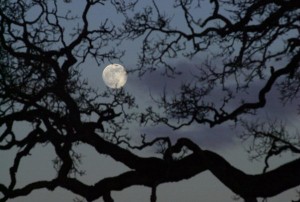
Press Democrat file photo
If you haven’t done a moonlight hike recently (or ever), this weekend offers a chance to bask in a Full Beaver Moon.
According to the Old Farmer’s Almanac, the November full moon, also called a Full Frost Moon, or a Frosty Moon, is an opportune time to set beaver traps before the swamps freeze. Otherwise, there won’t be a sufficient supply of furs to last through the winter. That version has its roots in the colonial American days when gathering fur in winter was the difference between survival and death.
I had never heard of it, but several
of the hiking groups I belong to are planning Saturday night hikes since the sky will be exceptionally bright.
My hikes recently have been of the early-morning or late-afternoon variety, with some locales being Annadel State Park, Helen Putnam Regional Park, Shiloh Regional Park and Jack London State Park. Fall colors are out everywhere.
The best full-moon spot for my money is at Point Reyes where Alamere Falls meets the ocean. But there’s really not a bad spot on a trail when your path is lighted naturally by only the moon’s glow.
Below is from the Old Farmer’s Almanac:
| Month | Name | Description |
| January | Full Wolf Moon | This full Moon appeared when wolves howled in hunger outside the villages. It is also known as the Old Moon. To some Native American tribes, this was the Snow Moon, but most applied that name to the next full Moon, in February. |
| February | Full Snow Moon | Usually the heaviest snows fall in February. Hunting becomes very difficult, and hence to some Native American tribes this was the Hunger Moon. |
| March | Full Worm Moon | At the time of this spring Moon, the ground begins to soften and earthworm casts reappear, inviting the return of robins. This is also known as the Sap Moon, as it marks the time when maple sap begins to flow and the annual tapping of maple trees begins. |
| April | Full Pink Moon | This full Moon heralded the appearance of the moss pink, or wild ground phlox—one of the first spring flowers. It is also known as the Sprouting Grass Moon, the Egg Moon, and the Fish Moon. |
| May | Full Flower Moon | Flowers spring forth in abundance this month. Some Algonquin tribes knew this full Moon as the Corn Planting Moon or the Milk Moon. |
| June | Full Strawberry Moon | The Algonquin tribes knew this Moon as a time to gather ripening strawberries. It is also known as the Rose Moon and the Hot Moon. |
| July | Full Buck Moon | Bucks begin to grow new antlers at this time. This full Moon was also known as the Thunder Moon, because thunderstorms are so frequent during this month. |
| August | Full Sturgeon Moon | Some Native American tribes knew that the sturgeon of the Great Lakes and Lake Champlain were most readily caught during this full Moon. Others called it the Green Corn Moon. |
| September | Full Corn Moon | This full Moon corresponds with the time of harvesting corn. It is also called the Barley Moon, because it is the time to harvest and thresh the ripened barley. The Harvest Moon is the full Moon nearest the autumnal equinox, which can occur in September or October and is bright enough to allow finishing all the harvest chores. |
| October | Full Hunter’s Moon | This is the month when the leaves are falling and the game is fattened. Now is the time for hunting and laying in a store of provisions for the long winter ahead. October’s Moon is also known as the Travel Moon and the Dying Moon. |
| November | Full Beaver Moon | For both the colonists and the Algonquin tribes, this was the time to set beaver traps before the swamps froze, to ensure a supply of warm winter furs. This full Moon was also called the Frost Moon. |
| December | Full Cold Moon | This is the month when the winter cold fastens its grip and the nights become long and dark. This full Moon is also called the Long Nights Moon by some Native American tribes. |

 , New York native, I spent half of my life hibernating indoors, but for the past five years I have basked in the thrilling opportunity to enjoy year round hiking on the many trails of beautiful Northern California. In this blog I will continue in the tradition of trailhead, to recap the hikes I have taken and share the insights of my fellow hikers. Along with day hikes, I am also interested in dog friendly trails, and backpacking trips as well. Please feel free to offer suggestions of where I should hike next, or share tales of where you have explored. . Guest blog entries are extremely welcome as are your photos from your own hikes.
, New York native, I spent half of my life hibernating indoors, but for the past five years I have basked in the thrilling opportunity to enjoy year round hiking on the many trails of beautiful Northern California. In this blog I will continue in the tradition of trailhead, to recap the hikes I have taken and share the insights of my fellow hikers. Along with day hikes, I am also interested in dog friendly trails, and backpacking trips as well. Please feel free to offer suggestions of where I should hike next, or share tales of where you have explored. . Guest blog entries are extremely welcome as are your photos from your own hikes.